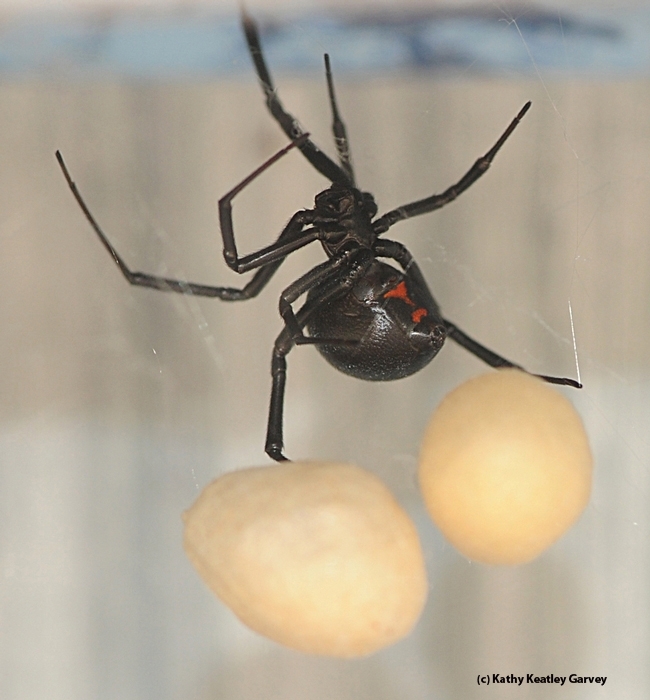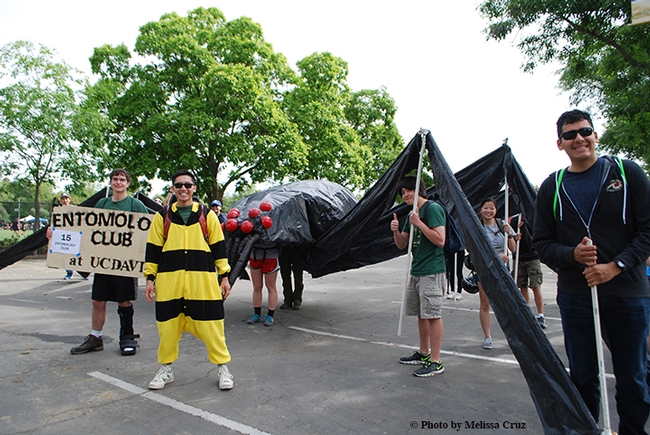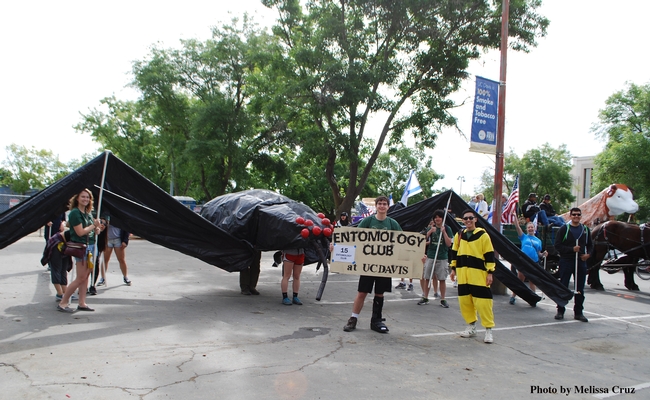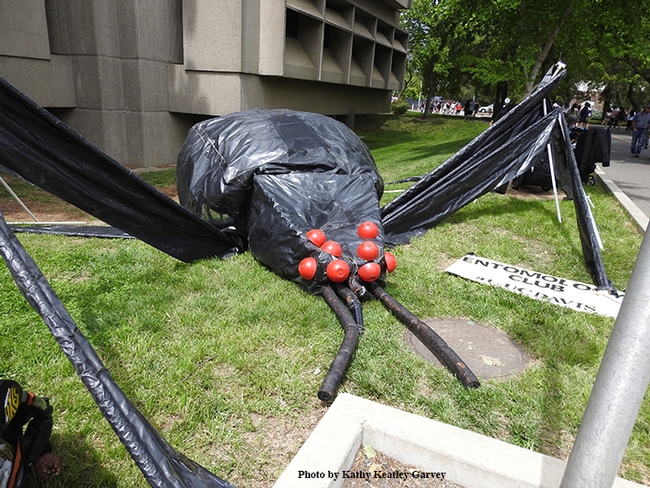
Sometimes it's found in a parade, where the "fear" turns to cheers and applause.
Take the case of the 40-foot black widow spider--yes, 40-foot spider!--that the UC Davis Entomology Club entered in the 103rd annual UC Davis Picnic Parade on Saturday, April 22.
The spider drew oohs and aahs from the crowd, and judges selected it the winner of the “Best Organization” category. It continued to draw oohs and aahs when the club showcased it in front of Briggs Hall on Picnic Day. Thousands of visitors stopped to look or capture photos with their families or take selfies. Little kids just stood and stared. "What's that, Mommy?"
What a spider! And complete with that distinguishing red hourglass marking.
“We built it three years ago,” related president Maia Lundy. “This year we just had to clean it up and make some modifications, like adding ventilation. It took us two meetings --or about 4 hours- of work this year. When we originally built it, we met several times over about a month to finish it. It's made out of plastic sheeting, chicken wire, pvc pipe, pool noodles, window screening, and held together by lots of duct tape and zip ties!”
The spider came to life in the backyard of entomologists Robert and Lynn Kimsey of the UC Davis Department of Entomology and Nematology faculty. Robert Kimsey, a forensic entomologist, serves as the club's advisor. Lynn directs the Bohart Museum of Entomology. Her specialty is wasps, but she answers all kinds of questions about insects and arachnids at the Bohart Museum.
The black widow spider is no stranger to the parade. It's reminiscent of the one that the UC Davis Entomology Club built for the parade about 25 years ago.
The Entomology Club decided to revive the project in 2015. It all took place in the Kimsey yard, and Robert Kimsey offered a blow-by-blow account then as he watched it develop from plastic sheeting to a black widow spider. “It is huge and currently in pieces as it is getting its skin and pedipalps and other minor body parts and whatnot. It is anatomically correct in every way! The students have been trained well in arachnology!”
“There are legs all over the place,” Kimsey said of the eight legs, each slightly less than 20 feet long. In real life, the body of the black widow spans about 1.5 inches long.
Kimsey said membership in the entomology club is open to all interested persons, including faculty, staff, college and high school students and community residents. (Contact entomologyclub@gmail.com.) President Maia Lundy heads the club with Jamie Fong, vice president; Andre Poon, treasurer; Lovey Corniel, secretary; and Chloe Shott, vice secretary.
As for black widow spiders, yes, the bite is venomous. The glands contain the neurotoxin, latrotoxin, which causes the condition latrodectism, both named after the genus, according to Wikipedia. "The female black widow has unusually large venom glands and its bite can be particularly harmful to humans. However, despite the genus' notoriety, Latrodectus bites are rarely fatal. Only female bites are dangerous to humans."
Take a bow, UC Davis Entomology Club. Well done! The prize: a certificate and a glass trophy.
The black widow spider joined seven other parade award winners:
- Best Community Entry: Davis Whymcycle Society
- Most Spirited: DEVO (Davis Enology and Viticulture Organization)
- Best Theme: Biological and Agricultural Engineering
- Best Animal Entry: Canine Companions for Independence
- Best Department Entry: UC Davis School of Veterinary Medicine
- Best Organization: Entomology Club
- Parade Marshal's Choice: Bakuhatsu Taiko Dan
- Parade Participants' Choice: West Plainfield 4-H Club, Woodland
Attached Images:

UC Davis Entomology Club members with the black widow spider float are (from left) Darian Dungey, James Fong, Chloe Shott (partially shown), Ben Maples (partially shown) James Heydon, Maia Lundy, Diego Rivera. Lundy is the president of the club. (Photo by Melissa Cruz)

UC Davis Entomology Club members "walk" the black widow spider in the UC Davis Picnic Day Parade. From left are Eliza Litsey, Ben Maples (in spider abdomen), Chloe Shott (in spider cephalothorax), Darian Dungey (holding sign), James Heydon, James Fong (in bee costume), Crystal Homicz, and Diego Rivera. (Photo by Melissa Cruz)

Following the parade, the black widow spider was showcased in front of Briggs Hall, home of the UC Davis Department of Entomology and Nematology. (Photo by Kathy Keatley Garvey)

A young child stares at the black widow spider in front of Briggs Hall, UC Davis. (Photo by Kathy Keatley Garvey)